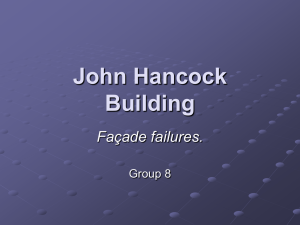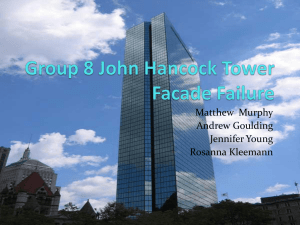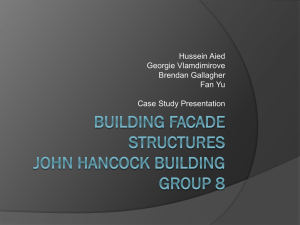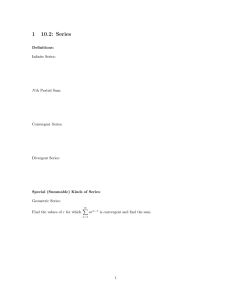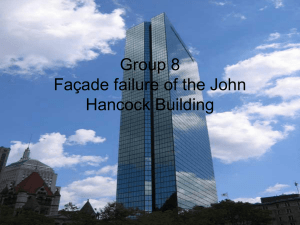Introduction.docx
advertisement
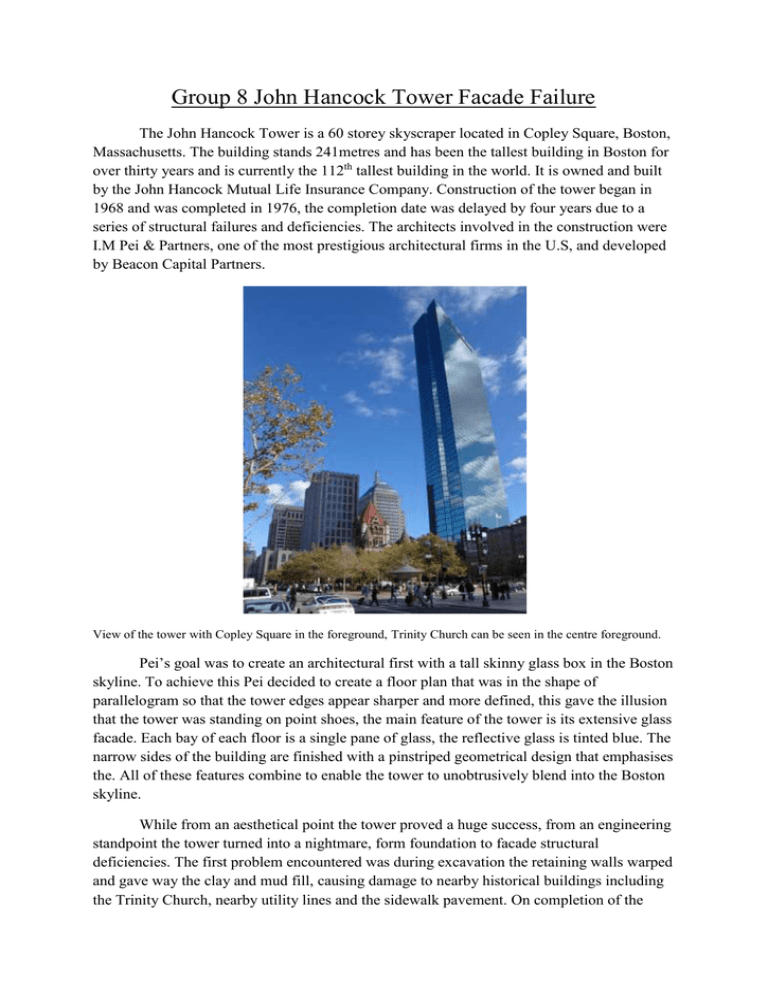
Group 8 John Hancock Tower Facade Failure The John Hancock Tower is a 60 storey skyscraper located in Copley Square, Boston, Massachusetts. The building stands 241metres and has been the tallest building in Boston for over thirty years and is currently the 112th tallest building in the world. It is owned and built by the John Hancock Mutual Life Insurance Company. Construction of the tower began in 1968 and was completed in 1976, the completion date was delayed by four years due to a series of structural failures and deficiencies. The architects involved in the construction were I.M Pei & Partners, one of the most prestigious architectural firms in the U.S, and developed by Beacon Capital Partners. View of the tower with Copley Square in the foreground, Trinity Church can be seen in the centre foreground. Pei’s goal was to create an architectural first with a tall skinny glass box in the Boston skyline. To achieve this Pei decided to create a floor plan that was in the shape of parallelogram so that the tower edges appear sharper and more defined, this gave the illusion that the tower was standing on point shoes, the main feature of the tower is its extensive glass facade. Each bay of each floor is a single pane of glass, the reflective glass is tinted blue. The narrow sides of the building are finished with a pinstriped geometrical design that emphasises the. All of these features combine to enable the tower to unobtrusively blend into the Boston skyline. While from an aesthetical point the tower proved a huge success, from an engineering standpoint the tower turned into a nightmare, form foundation to facade structural deficiencies. The first problem encountered was during excavation the retaining walls warped and gave way the clay and mud fill, causing damage to nearby historical buildings including the Trinity Church, nearby utility lines and the sidewalk pavement. On completion of the building it was discovered that in certain wind conditions the sway of the building was above acceptable standards. To counteract this 300 ton weights were added on the 58th floor which acted as dampers to prevent the swaying of the upper floors. However, the most famous and embarrassing failure of the structure was the failure of the glass panels of the curtain wall facade. The facade was originally covered with 10,344 double-paned insulating reflective glass, the panes were separated by a 13mm air space. Shortly after the completion of construction in 1972, the glass panes began to crack and by October 1973 3500 panes had cracked some of which had fallen onto the streets below. This resulted in major disruption to the city centre as police had to close off surrounding streets when winds reached 72km/hr. The cracked panels were temporarily replaced with plywood panels while testing was carried out to try and remedy the problem. The double panes were replaced with single tempered safety glass panes of the same dimensions as the original double panes. The reglazing began in May 1974 and was completed in August 1975, at a reported contract cost of 8.5$ million. This picture shows the facade complete with plywood panels From the moment the panes began to fail in late 1972, myths with varying degrees of truth began to emerge as possible explanations to the failure. The first of which, attributed the failure to the swaying of the building induced by the wind which caused a stress and pressure build up in the panes causing them to crack and ultimately fail. Another theory which emerged was that the rhombus shape of the structure in combination with the wind resulted in the formation of hot spots causing thermal stress to lead the panes to failure. Both of these theories were proven inaccurate as a result of wind tunnel tests carried out in the University of Western Ontario, Canada. Another myth circulated that settlement in the foundations led to increased stress in the panes causing failure. The most widely accepted theory put forward held the unique double glazed bond technique responsible. The glass units were made up of two panes connected by a lead tape spacer which was soldered to each of the panes. The inside surface of the outer pane was coated with a highly reflective chromium film which was in turn soldered to the lead spacer. The chromium film was included to reduce glare. It was this bond that led to the ultimate failure of the panes. This bond between the film and lead spacer was too strong and rigid and didn’t accommodate any vibrations induced by the wind or any thermal movement. Due to repeated thermal movement and wind vibrations, the soldered connection fatigued and cracked leading to increased stresses in the outer pane. This in turn caused cracks to form in the outer pane and in many cases led to ultimate failure. This image shows a cross section of the original windows. The lead spacer can be seen in the middle, bonded to the two panes. Unfortunately, it has been nearly impossible, even to this day, to access reliable information about the John Hancock case. In a court hearing in 1981 a settlement was reached that included provision for an oath of secrecy regarding the exact details of failure. As a result of the facade failure, the dangers involved in using new design in large scale buildings, such as the original pane design, without sufficient testing became evident. The consequences of this led to major financial losses, public embarrassment, time delays and danger to public safety. There are lessons in the John Hancock case for geotechnical and foundation consultants, curtain wall designers, wind researchers, structural engineers, architects and building owners. As a direct result, building regulations in the U.S now recognize non-uniform, fluctuating wind pressures. The facade failures experienced by the John Hancock Building led to greater use and redesign of wind tunnel testing and to other advances in the field of wind engineering.
